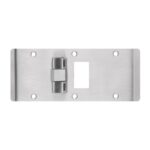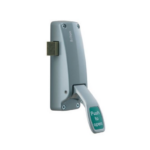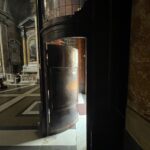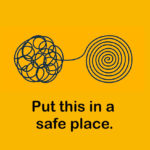 Last week, a code official contacted me because he had seen some egress doors in a school that were equipped with sensor bars used to release electromagnetic locks. What caught his eye was the signage on the doors, instructing building occupants to remove their gloves before pressing on the bar – assumably because the bars will not work when a person is wearing gloves.
Last week, a code official contacted me because he had seen some egress doors in a school that were equipped with sensor bars used to release electromagnetic locks. What caught his eye was the signage on the doors, instructing building occupants to remove their gloves before pressing on the bar – assumably because the bars will not work when a person is wearing gloves.
The school is located in a state that is often very cold in the winter, so it is not uncommon for people to put their gloves on before leaving the building. In my opinion, the signage directing people to remove their gloves constitutes “special knowledge or effort,” since people would need to read the sign and follow the instructions before they are able to exit (the code official agreed with this interpretation).
There’s another problem with this application when used in a school. The model codes require doors to be equipped with panic hardware when they are serving assembly or educational occupancies with more than 50 people (IBC) or more than 100 people (NFPA 101). If a door is not equipped with a lock or latch (if it has push/pull hardware only), panic hardware is not required. But if the door has any sort of a lock or latch – including a mag-lock, it has to have panic hardware.
Although there is panic hardware available that can incorporate a switch to release a mag-lock, sensor bars that do not latch are not typically listed as panic hardware. Panic hardware must be listed to the UL 305 standard; if a sensor bar is not listed to UL 305, it is not panic hardware and is not allowed to be used to release a mag-lock on a door that is required to have panic hardware – unless the AHJ allows it.
If you need more information about electromagnetic locks and the code requirements that apply to these applications, there is a Decoded article here. For more information about panic hardware, there is a Decoded article here, and a whiteboard animation video here.
You need to login or register to bookmark/favorite this content.






Yea
My favorite subject!!
Lori,
I think your point about the panic rating is interesting and could be a problem. There is a product (might be more out there) that does address the issue of gloved hands. Securitron’s Dual Sense Bar (DSB) has both mechanical switches and touch sense. In fact, they bring up the point of people with prosthetics and otherwise not able to touch the bar.
Great topic and outside the box thinking about safety issues we run into!
Thanks Joe!
– Lori
I’m not sure to have understand why they need to remove glove before to use the bar? It will obstruct into the sense bar?
Also, did they forget also the manual station or other emergency releasing device ?
Hi Maxime –
With this particular type of bar, it senses the person’s hand and releases the mag-lock but will not sense the hand if the person is wearing thick gloves. This application – a mag-lock released by door-mounted hardware – does not require the manual push button / emergency release device. There’s some more info about the required releasing devices for mag-locks here: http://idighardware.com/2017/07/decoded-access-controlled-egress-doors-august-2017/
– Lori
Great article Lori!! Thank you for publishing!
Is it in Braille and fifteen different common, languages?
What’s wrong with using a 99 RIM or vertical rod panic with a Signal Switch (SS or RX option)?
For that matter just use the latching panic bar and skip the mag lock altogether.
If it has access control it can be an EL or QEL
Hi Domenic –
There would be nothing wrong with using listed panic hardware.
– Lori
Do language barriers qualify as “special knowledge or effort,”…?
That’s an interesting question. The model codes are specific about what signage has to say – for example, with delayed egress locks. If you installed an English delayed egress sign on a door in a country where English is not spoken, I think it would require special knowledge to know how the door will operate.
– Lori
I was thinking more along the line of recent immigrants / ESL (English as a Second Language), and/or foreign exchange students, whom might be resident within the school populace maybe…
I don’t think there is a legal requirement in most jurisdictions for signage to be in languages other than English, but it may make sense to include the translation in locations frequented by people who do not speak English. I’ll see if I can find any precedent on this.
– Lori